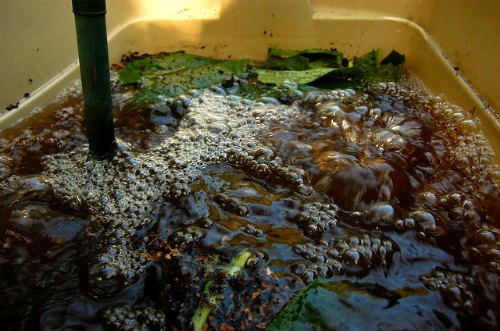Mode of action in the soil
Soil is to plants as the stomach is to humans.
The food web in the soil is a highly complex community of life involving countless organisms. In the graphic above, the food web is shown in simplified form. From left to right, the organisms are continuously preying on the next organism in the food chain.
Bacteria, protozoa, nematodes and fungi can be introduced into the soil through the compost tea. The organisms introduced through the compost tea represent the basic length of the food chain and are thus indispensable for a fertile soil.
Action on the leaf surface
A good immune system means a high microbial activity and diversity in and on the body. The number of microbes in and on the healthy human body is 10-100 times higher than the number of cells that make up the human body.
Our skin secretes substances that attract and feed microorganisms. These then compete with the pathogens, preventing them from settling and spreading.
It is the same with plants. The plant secretes substances to attract those microorganisms that protect the plant from diseases and pests.
Contents
- 1 What role does temperature play in the brewing process?
- 2 Should the ingredients be added to the brewer in a certain order?
- 3 What to do if too much compost tea has been made?
- 4 What can be done with the filtered out residues of the brewing process?
- 5 What should the compost tea smell like?
- 6 Isn’t making compost tea too energy intensive?
- 7 Author
What role does temperature play in the brewing process?
It is important to keep an eye on the temperature. Basically, it can be said that temperatures between 10 – 27 °C work to brew good quality compost tea. The optimal range is between 17 – 22 °C. At cooler temperatures, the microorganisms multiply more slowly. Therefore, the brewing time should be adjusted as follows: 10 – 17 °C with 36h brewing time and at 18 – 27 °C 24h brewing time. However, the brewing times of different brewing devices can vary considerably. It can be assumed that the compost tea can get better accustomed to its new environment after brewing if it has already had temperatures like those found in the soil during the brewing process.
Should the ingredients be added to the brewer in a certain order?
First comes the water. If tap water is used that has chlorine added to it, the water should not be used until 2 hours after bottling so that the chlorine evaporates. Chlorine is very harmful to microorganisms, so it is recommended to obtain information about the regional tap water. Be sure to turn on the air supply from the beginning to oxygenate the water. Then follow the ingredients to mix evenly and finally the compost. In this way, the microorganisms in the compost will find the right conditions to multiply in the water from the beginning.
What to do if too much compost tea has been made?
Compost tea can be poured anywhere soil occurs. Add it to the compost pile, on a lawn, to shrubs and trees, etc. It is best to always brew as much compost tea as is needed.
What can be done with the filtered out residues of the brewing process?
The remaining solids can be evenly distributed on a compost pile or spread on the soil in the garden. The organic solids contain a very high number of microorganisms.
What should the compost tea smell like?
Generally, compost tea should have an earthy, sweet soothing taste. If algae meal, fish hydrolisate or chitin from oyster shells, for example, is used, the compost tea will have a fishy or sea-like taste. The tea should never have a sour or rotten smell, as this is a sign that there was not enough oxygen in the water during the brewing process.
Isn’t making compost tea too energy intensive?
Small brewers tend to use more electricity than larger brewers. On average, it is 1 watt of air pump power per 1l of compost tea. So the production of 30l of compost tea at 24h brewing time corresponds to a weak light bulb that is switched on 24h.


